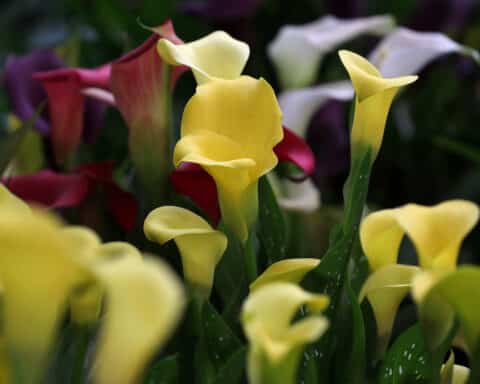This is the second of a five-part series on creating a rosary garden for your home or parish; each month I present a group of Mysteries and list a companion plant for each meditation, concluding in May. In this way you can plan or build your rosary garden, one step at a time.
This month we will consider the Luminous Mysteries — also known as the mysteries of light — meditations that were instituted in 2002 by Pope Saint John Paul II in his apostolic letter “Rosarium Virginis Mariae.” These are mysteries that open us up to ponder how the light of God is manifested through Jesus, the Light of the World.
The rosary is a greatly favored prayer that evokes a sense of time, place and peace as we meditate through the pater and mater beads. The word rosary comes from the Latin word “rosarium”, meaning rose garden, then came to mean “a garden of prayers” leading to the printing of a prayer book, “hortulus animæ”, that literally meant “little garden of the soul.” It was during the fifteenth century that the rosary evolved into its present form.
You may decide that rather than create a large four-part rosary garden, a plant or two from each mystery is sufficient for a smaller “Marian garden.”
There are dozens of plants familiar to us in their Christian symbolisms, but how they may be used often depends on region and culture. I’ve tried to narrow things down to only one plant per meditation, useful in many regions. You may know of other plants that will fit just as well within the theme and are more suitable for your USDA Hardiness Zone.
The Luminous Mysteries:
The Baptism in the Jordan
Gratitude for Faith: The columbine is one of the more familiar plants in Christian symbolism. Its common name indicates a bird, from the Greek “kolymbos” for “small bird,” It is symbolic of the Holy Spirit. All four gospel writers, when describing the baptism of Jesus, speak of the Holy Spirit descending “like a dove.”
The botanical name “Aquilegia” touches on how water beads up on the leaves, reminding us of the waters of baptism. The plant develops solid roots, as the rosary helps us be more rooted in our faith.
The Wedding Feast at Cana
Fidelity: This first miracle through Jesus is closely associated with grapes as he changed water into wine. This miracle also centers on fidelity, not only the promise of fidelity in marriage but also to God’s plan, to his mother and her request, who intercedes for us as she did for the couple, and of those whose hearts were opened by this miracle. “Myrtus communis” is symbolic of fidelity.
The myrtle In Christianity is an emblem of the marriage bonds — the vows of love, chastity, and fidelity. In ancient times it was common to weave crowns of myrtle for brides and grooms, and for branches to be carried or placed in the sanctuary during religious vows. Legend has it that when Mary and Joseph were married, she wore a wreath of the sacred myrtle braided with roses on her head.
The Proclamation of the Kingdom of God
Desire for Holiness: this is the time that the Gospel is being preached — the Sermon on the Mount, when Jesus encourages repentance and offers forgiveness of sins. The crocus represents forgiveness.
For Christians, the spring-flowering crocus, “Crocus vernus” is symbolic with making amends and forgiveness following a wrongdoing, and is also known — as are a few other plants — as the “Penitent’s Rose.” The crocus represents the eternal soul which blooms when we, through love, are forgiven.
The Transfiguration
Spiritual Courage: Here we learn of Jesus being supported and changed in preparation to his surrender of his earthly life. In the modern language of flowers, the butterfly weed, “Asclepias tuberosa,” is indicative of letting go.
Butterflies live only a few weeks to a few months, reminding us that life is short. When we think of death we are reminded of our own metamorphosis, letting go of a previous life on earth for the freedom of a life in eternity with God. It takes great spiritual courage to trust in a conversion from a physical life to a spiritual one.
The Institution of the Eucharist
Love of Eucharistic Christ: Basil, “Ocimum basilicum“, is known as the holy Communion plant. Its name comes from the Greek word for royal, or kingly, “basileios.”
On holy days, basil, with its deep purple flowers symbolic of suffering, was often strewn at the foot of a cross as well as strung on Communion rails. This plant has been a sign of love for centuries; God’s love for us and our love of him.
Rosary garden colors for the Luminous Mysteries are traditionally purples or deep burgundies, but yellow and white are also used as representations of the colors of light.
Next month, we’ll cover the Sorrowful Mysteries.





